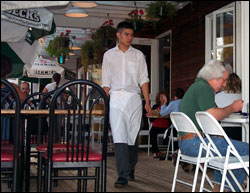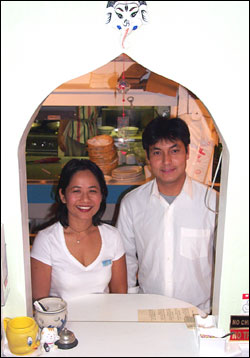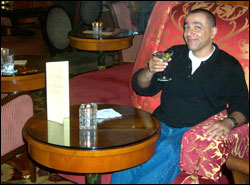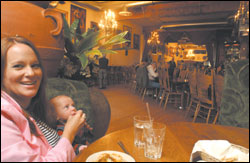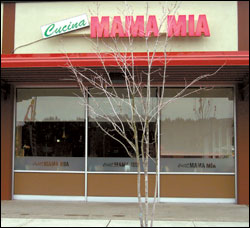It’s hard to miss the South Asian restaurant lineup in the University District: Indian, Pakistani, Bangladeshiwhat have you. But in a place where there are as many bargain curry buffets as there are porters at Victoria Terminus, Bombay’s teeming train station, Cedars stands out. Arriving at this U District favorite on a recent Saturday evening, we were reminded why: When it comes to Indian and Middle Eastern eats on the cheap, trusty, sprawling Cedarswith its famous wooden verandais the raja of the realm. How do they do it so well? An extensive dinner menu, with most entr饳 under $12, runs the gastronomic gamut from sweltering Ramallah (in Palestine) to Rawalpindi on the windswept plains of West Punjab (modern Pakistan). On any night, the grub on your plate speaks to at least three distinct culturesIndian, Pakistani, and Middle Easternand many more influences, including colonial Brit (of which more later).
On a recent Cedars night out, my companion enjoyed shish taouk (cubed chicken marinated in garlic, oregano, saffron, and other Middle Eastern spices and served in the traditional Arab way on a bed of fragrant rice with a side of vegetables, $9.95). For contrast, I went for Cedars’ royal biryani ($12.95), a classical Indian (well, Mogul) curried rice dish. Both were excellent. But what made this meeting of South Asia and the Middle East possible (in Seattle, of all places)?
Proprietor Mohammed Bhatti explained that the present chef is Indianan earlier one was Lebanese. Bhatti hails from (Muslim) Pakistan, which has enduring cultural ties with the Arab Middle East. The three met here, economic immigrants in a shrinking world, and instead of limiting the menu to any one cuisine, Bhatti decided his restaurant would serve Indian and Pakistani as well as Middle Eastern food. But Cedars dodges the fusion/confusion bullet by keeping Indian and East Mediterranean dishes separate on the menu. Each has its section, and the cooking stays authentic and true.
THE FORMULA WORKS like a charm. Feel like a trip back to the British Raj? Try the mulligatawny soup ($3.95), a zesty South Indian broth from chicken stock seasoned with curry. The name comes from the Tamil milakutanni (roughly “fire water”) and presumably came into the English language (and kitchen) by way of vile colonialism and the British refusal to pronounce anybody else’s language correctly. But Cedars’ mulligatawny is proof that not all by-products of India’s English occupation were bad.
For a change of scene to the Mediterranean, order Cedars’ excellent tabbouleh ($3.95). The chopped parsley leaves, tomatoes, green onions, and cucumbers are sure to be fresh, the bulgur (cracked wheat) light and fluffy, and Cedars’ signature dressing zesty with a good hint of lemon. Better still, “fuse things together” with the Cedars “surprise” ($5.95). This hearty platter of appetizers has something for everyone. It includes dolmades (stuffed grape leaves) and a flaky spinach pie, both from the Mediterranean. India is represented by fried veggie cutlets, a samosa (a spicy potato turnover served with tamarind and cilantro chutney), and vegetable pakorasdeep-fried veggie fritters and standard bar food in India.
Best of all, Cedars boasts a real tandoor, a traditional subcontinental clay oven, making the kitchen capable not only of luscious dry-roasted meats but also out-of-this-world chicken tikkas, authentic leavened and unleavened Indian breads (naan, kulcha, and paratha), and a variety of Indian kebabs.
ON A SUMMER NIGHT, be sure to sit outside and enjoy the breeze on Cedars’ wooden veranda. With its simple furnishings and unpretentious location adjacent to a parking lot, the veranda may not be exotic, but you still could be in Bombay or Beirut. Work up to your meal with some of Cedars’ 200-plus beers from round the world. They will transport you to wherever it is you want to goor if you happen to be a homesick exile, back to where you came from.
Cedars’ selection of Indian beer is particularly impressive. Until recently, Indian beer tasted mainly of the preservatives that ensured its passage to the West. Now you can taste the true warm, tropical flavor of these robust, hoppy brews. We enjoyed ours in the traditional South Asian way to the accompaniment of aloo parathas ($3.95), leavened bread stuffed with spiced potatoes, and veggie samosas (also $3.95).
There are at least six Indian beers on the list, including Kingfisher, Taj Mahal, Haywood’s 5000, Royal Challenge, and Golden Eagle, but Himalayan Blue is the cream of the crop. From Sikkim, a former princely state in the Himalayas, it’s light (4.5 percent alcohol), brewed with Himalayan spring water, and hard to come byeven in India. Like mulligatawny, the brews are another reason for South Asians to be grateful to the Englishat least while drinking their beer.
